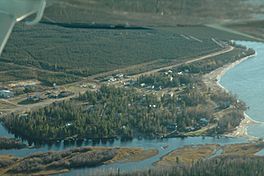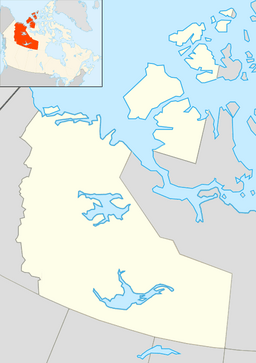Sambaa K'e (lake) facts for kids
Quick facts for kids Sambaa K'e |
|
|---|---|
| Trout Lake | |

The settlement of Sambaa K'e, on the south shore of the eponymous lake
|
|
| Location | Dehcho Region, Northwest Territories, Canada |
| Coordinates | 60°33′N 121°14′W / 60.55°N 121.24°W |
| Primary inflows | Paradise River East, Island River, Moose River |
| Primary outflows | Trout River |
| Catchment area | 5,694 km2 (2,198 sq mi) |
| Basin countries | Canada |
| Max. length | 51 km (32 mi) |
| Max. width | 15 km (9.3 mi) |
| Surface area | 504 km2 (195 sq mi) |
| Surface elevation | 503 m (1,650 ft) |
| Settlements | Sambaa K'e |
Sambaa K’e (pronounced SALM-bah-kay) is a beautiful lake located in the Dehcho Region of the Northwest Territories in Canada. Its name comes from the South Slavey people and means "place of trout." For a long time, both the lake and the small community on its shore were called Trout Lake. However, in 2016, their names were officially changed to Sambaa K'e to honor the local language and traditions.
Contents
Exploring Sambaa K'e Lake
Sambaa K'e is a large lake, about 103 kilometres (64 mi) long and 12 kilometres (7.5 mi) wide. It covers an area of 513 square kilometres (198 sq mi). The lake sits at an elevation of 503 metres (1,650 ft) above sea level.
Rivers Flowing In and Out
Many rivers bring water into Sambaa K'e. These include the Paradise River East from the east, the Island River from the south (which flows near the community), and the Moose River from the north. The lake's water then flows out through the Trout River from the northeast. The Trout River is an important branch of the much larger Mackenzie River.
Water for the Community
The people living in the community of Sambaa K'e get their drinking water directly from the lake. This water is treated at a special facility to make sure it is safe to drink. Keeping the lake water clean is very important for everyone who lives there.
Keeping the Water Clean
Sometimes, things can get into the lake water. For example, water from the local sewage system and some old materials from a World War II-era outpost near the lake have been known to affect the water. Also, sometimes fuel from the local power station can leak. People are working to make sure these things do not harm the lake's water quality.
Animals and People at Sambaa K'e
Sambaa K'e is a popular spot for fishing. People come here to catch fish like lake trout, walleye, northern pike, and Arctic grayling. Fishing is not just a fun activity; it's also a big part of how the local people live.
Traditional Ways of Life
The people of Sambaa K'e rely on the lake and its surroundings for much of their food and livelihood. They hunt, trap, and fish, just as their ancestors have done for many generations. Some of the traditional foods they gather include:
- Moose
- Woodland caribou
- Grouse
- Porcupine
- Beaver
- Trout
- Pickerel
- Duck
- Various types of berries
Protecting the Area
There is a plan being studied to create a large protected area around Sambaa K'e. This area would be about 10,600-square-kilometre (4,100 sq mi) and would help protect the lake and all the land around it. This would ensure that the animals and plants, and the traditional way of life, are preserved for the future.


